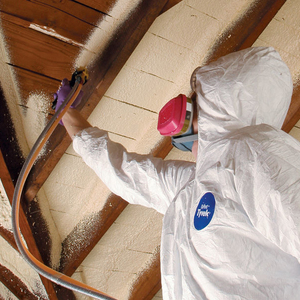pine clapboard and cedar shingles over 2″ styro
I am building a house for a customer who wants 2″ styro over the exterior. The lower half of the walls will have pine clapboard and the upper half will have cedar shingle siding. I would like to incorporate a rain screen of some kind. I considered using metal strap cross bracing then applying the 2″ styro and sheathing over it, then applying either a rainscreen product or a lath and tar paper combination. but I really dislike that plan. The building will be on the atlantic coast where both wind and driving rain are an issue. I don’t want any racking. I really want the sheathing on the studs. What advice do you have for me? Maybe you know of some relevant articles or books on this subject? Thanks Jay



















Replies
Let me first say that if I were building a new house, I'd consider all ways to keep the insulation within the wall structure rather than hanging foam on either the inside or the outside. This opinion comes from direct experience having done it both ways; here in the PNW (exterior) and Alaska (interior). Working with foam requires extra time and detailing around openings. Add that to the additional complexity of a rainscreen and your budget may get a severe stomping.
Nevertheless, I think that a layer of xps foam really tightens up a building to air exchange. Both my houses that I retrofitted became very energy efficient. Mine were remodels and both have 2x4 walls which can contain only so much fiberglass or cellulose. Also, both had plywood sheathing soundly attached to the exterior of the structure, so no problem with shear. I am positive that any sheathing applied over a layer of foam would not qualify as a shear wall.
The references jimblodget gave were also invaluable to me when I was designing the remodel here in the PNW. Besides wanting to add insulation I was determined to stop any wind driven rain, of which, we have plenty. I did a rainscreen with horizontal cladding, which is a bit more straightforward than anything that requires horizontally placed nailing battens.
Another good method of building is using SIPS. Have you considered them?
Best of luck on this project. Research is your friend because opinions are all over the map.
Thank you for your reply. And I agree with you I would rather have a double stud wall but my customer wants it done other wise which is fine with me. It looks as if I will be using Roxul Comfort Board IS and following the recommendations of Building Science consulting. The walls will be framed 2x6 @ 24" OC with Roxul Batt insulation. Sheathing over Studs followed by a drainage plane and exterior air barrier membrane. That will be covered with 1.25" Roxul Comfort board. strapped over with 1x3 then wood siding attached. It will probably work well. Do you have any experience with this product or method?
What you outline here is essentially how I did my home in the PNW. Except I didn't use the Roxul products and I placed the wrb to the exterior of the foam, right beneath the strapping. I don't understand any advantage in placing the drainage plane between the foam and the sheathing, as you have proposed. Although I understand that it is common practice with some. Also, the wrb I used acts as the air barrier as does the foam itself. So I see no need for an additional material to act as such.
In any case, your approach seems well thought out and ought to perform well. Still, the weak knee is the penetrations. Don't skimp out on flashing. Think it all through and train the installers well. Don't expect that a window can be installed in the same amount of time that we did in the old days when "flashing" was only something an old guy in a trenchcoat did down on main street.
Another thing... be sure to anticipate all your penetrations such as hose bibs, electric outlets, etc. Cutting one of these into a finished rainscreen wall is a pain in the neck to do properly.
pine clapboard and cedar shingles over 2" Styro
Thank you for your input. I've been looking up what you recommended and not sure what will be the final decision. Have been looking Roxul products.
to many steps
Not really sure where your customer got the idea from but it seems like a lot of work for what could be some real headaches done the road for you. It would seem to me that framing with 2x6 and using spray foam on the inside would give them the best result couple that with the Zip Wall system where the plywood joints are taped will make the house very tight and of course structurally sound.
The customer probably does their research...
Spcollins wrote:
Not really sure where your customer got the idea from but it seems like a lot of work for what could be some real headaches done the road for you. It would seem to me that framing with 2x6 and using spray foam on the inside would give them the best result couple that with the Zip Wall system where the plywood joints are taped will make the house very tight and of course structurally sound.
Spending a premium on spray foam in the bays still does nothing to address thermal bridging from the studs. As far as true "whole wall" R-value is concerned, you'll get a significantly more efficient structure with proper air sealing, a zone-appropriate amount of exterior EPS or polyiso, and a much cheaper than spray foam cavity fill (cellulose would be my choice). All of that for no more money than what you're spending on spray foam in the cavities... and possibly a good amount less money. I've seen a lot of experienced and old-school types downplay the benefits of exterior foam or imply that throwing the most expensive insulating materials between the studs is just as good. The laws of physics say otherwise; and without question.
another opinion...
I'm down near the CT shoreline.
Here, a common detail for exterior foam is to sheath over the studs with your choice of exterior shething.
Then 2" RFBI. That can be a single layer of 2" foam with the seams between sheets foamed for tightness, or two layers of 1" foam with the seams offset.
Then vertical strapping over the foam, with the strapping fastened through the foam and sheathing and into the wall studs. So the strapping essentially ends up telegraphing the stud locations. Then the clapboard siding gets nailed off onto the strapping.
In your case, the lower walls could have vertical strapping over the studs for the for the claps. The upper walls could have horizontal strapping for the shingles.
Horizontal strapping phobia
There would have to be a very good reason for me to strap horizontally immediately behind siding. The top edge of that strap(s) seems a likely place for water to sit around waiting to do damage.
The house we're currently building has vertical rain screen slats behind where horizontal lap will be applied, but we decided to use a roll out membrane (Home Slicker) behind the sections that will be shingled.
Seems right to me.
agree
Sir!
You are correct!
I should have typed more to 'splain more.
You strap vertically over the entire wall. Then add horizontal OVER the vertical where the shingles will go. Sorta like this:
View Image
Hmmm.
Haven't ever considered that detail before. That would be better, for sure. Are the tops of those horizontal straps beveled maybe? Or would water still collect on the top surface in low spots?
Still seems problematic, but like I said, I haven't given this detail more than the past 5 minutes of thought.
Wouldn't there still be the potential for a wet line where the back of the shingles intersect that top/outside edge of each strap? Not on every shingle, certainly, but at low or soft spots in the strap material? Maybe those straps are sloped end to end to drain?
Edumacate me, old friend.
no worries
Tthe flat tops on the horizontal strapping are not a negative issue at all.
Quite a few guys in New England just nail the horizontal strapping for shingles tight to the sheathing. If they use any at all. The conscientious ones? They might kerf the back side of the horizontal strapping and then nail it right to the sheathing, believing that the kerf lines will allow any accumulated liquid moisture to drain. I don't particularly care for that method. I'd rather have the horizontal strapping for shingles completely off the house wrap or sheathing.
I've never seen wet areas or moisture lines like you describe.
Out here, coastal building is a little different than inland construction due to wind and wind-driven rain, so perhaps I think a little more conservatively due to the big DANGER sign that back in the day would occasionally come to me in my dreams.
The home slicker mesh material that you use is common for shingles, but directly over sheathing. When exterior foam is used over the sheathing, not so much.
This photo certainly proves an attention to detail and best practice that is sorely lacking in most construction. I think this is what I'd have done on my house had we opted for shingles. The horizontal strapping isn't really problamatic in my estimation since it is itself hung on a rainscreen.The cladding and the strapping are easily dried naturally.